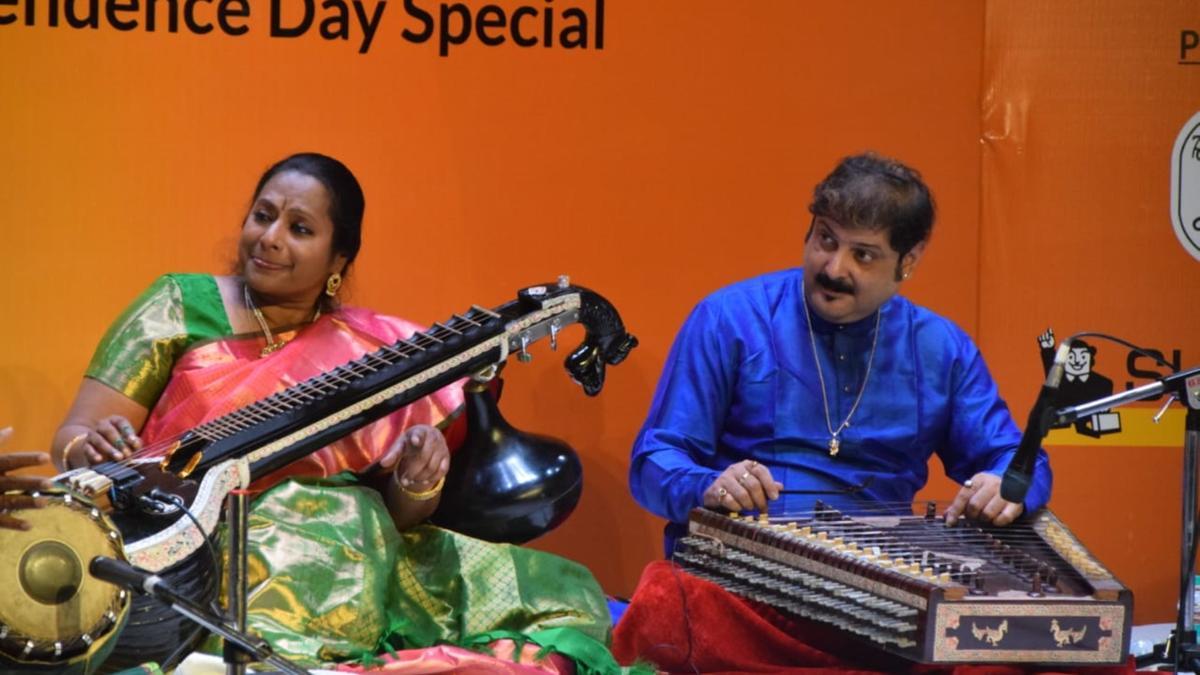
The Saraswati veena epitomises India’s ancient classical music while the santoor is inextricably linked to the folk tradition of Kashmir. Bringing these two instruments together on stage could be a novel idea. The U.S.-based vainika Nirmala Rajasekar and Kolkata-based santoor artiste Sandip Chatterjee attempted this rare jugalbandi recently in India before embarking on their current America tour.
Together they make music with 100 strings — santoor’s 93 (Sandip removed seven strings from the 100-stringed instrument) and veena’s seven strings.
Nirmala, a ninth-generation veena exponent, shared how exciting this musical association is. Apparently, the veena and the santoor came together earlier in a concert by Kannan Balakrishnan and Bhajan Sopori, organised by Sangeet Natak Akademi.
Nirmala and Sandip performed in Delhi, accompanied on the tabla by Ramdas Palsule and on the mridangam by Thanjavur K. Muruga Bhupathi. The concert had been structured with care to showcase the distinctness of the instruments and their ability to create a musical confluence. Since there are many ragas common to Hindustani and Carnatic systems, the jugalbandi was a smooth exercise.
While Nirmala chose to play an ode to Ganesh ‘Gam Ganapathe,’ which she sang too (it sometimes diverted the focus on the instrument) with the mridangam enhancing the melody with rhythmic support, Sandip presented a different ‘gat’ in Hamsadhwani, ably accompanied by the crisp tabla bols of Ramdas Palsule.
Acoustically speaking, the bass sound of the veena is in total contrast to the light, fluttery sound of the santoor. Also, the level of movement and dexterity in the santoor is difficult on the veena, but the movement within notes possible on the veena is unachievable on the santoor, or ‘shatatantra’ veena as Nirmala prefers to call it. However, both used these aspects to complement each other’s playing.
Sandip remarked, “My santoor is usually tuned to ‘D,’ but I had to change my pitch to play in ‘E’.” Nirmala explained that her veena had been made shorter so that she could travel with ease. As a result, it cannot be tuned lower than ‘E’. Sandip shared, “Instead of re-tuning the santoor to a pitch where it may not resonate well (each instrument sounds best at a certain pitch), I changed my scale and made ‘Re’ my ‘Sa.’ This is difficult to sustain in a long concert, but I like challenging myself.
.”
Sandip’s santoor playing is unusual. He plays with one mallet, unlike the norm where both hands hold mallets to skim on the notes. “I try to emulate Ustad Vilayat Khan saheb’s handling of the ‘tarab’ (sympathetic) strings. I use just one mallet, and with the other hand pluck the ‘tarab’ wires; it sounds beautiful. My instrument has only two ‘tarabs’; I removed the other two since it resonated too much. In music, it’s not hard to find a meeting point,” said Sandip.
The collaboration between these maestros was nothing short of an innovative musical journey. They brought together the classical and folk traditions of India in a spectacular confluence, demonstrating not just their individual mastery but also their ability to blend seamlessly, despite their instruments’ inherent differences.
Their performance was a testament to the rich tapestry of Indian music wherein the rigidity of classical forms and the fluidity of folk traditions can coexist. The meticulous planning that went into the performance was evident in how harmoniously the different elements interacted on stage.
The musicians’ dedication to adapting their playing styles to suit each other was extraordinary. Nirmala’s veena, with its deep, resonant tones, provided a grounding backdrop to the high, shimmering sounds of Sandip’s santoor. They managed to strike a balance that was both aesthetically pleasing and musically enriching.
The presence of seasoned accompanists like Ramdas Palsule on the tabla and Thanjavur K. Muruga Bhupathi on the mridangam further elevated the performance. Their rhythmic frameworks added a layer of complexity and excitement that kept the audience thoroughly engaged.
Post this unique collaboration in Delhi, the artists are expected to embark on an international tour, taking this innovative jugalbandi to audiences in the United States. This initiative not only promises a new auditory experience for global audiences but also acts as a cultural bridge, showcasing the vast musical heritage of India.
Ultimately, the event was more than a concert; it was an exploration of the boundaries of traditional Indian music. The merger of the veena and the santoor on one stage highlighted both the uniqueness and the universal appeal of these stringed instruments. For those who witnessed it, the jugalbandi was an unforgettable experience, a blend of familial and cosmopolitan influences, ancient practices, and modern interpretations.












